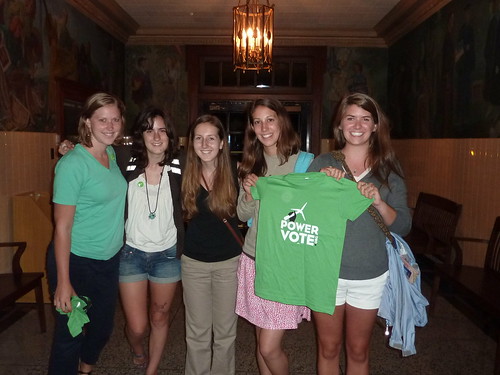Joe Romm has an open thread today at climateprogress.org, in which he asks, “What should climate hawks do now?“
Here is my suggestion:

As the Maryland campaign director at the Chesapeake Climate Action Network, I work with a coalition of climate hawks poised to move strongly forward at the state level as we determine the best next steps nationally.
Since this year’s failure to pass comprehensive climate legislation in the senate, a number of groups and individuals have discussed the need for state level action. At the state level, we can make real gains in renewable energy and emissions reductions, while tangibly showing that climate solutions work. Thank God California’s AB 32 law will continue.
In Maryland, we also have strong climate laws on the books, including a 20% RPS by 2022 and an emissions reduction goal of 25% below 2006 levels by 2020.
To meet these goals, action is still needed.
As an ocean state, offshore wind power currently has the highest potential for us to generate clean, renewable energy. That’s why we’re part of a strong coalition calling on the Maryland General Assembly to pass legislation that will bring us offshore wind parks as early as 2015.
Offshore wind will bring Maryland reliable jobs (thousands in construction, operations, and maintenance), reliable energy (Europe’s had offshore wind working since 1991 and we could get a third of our power in the region from the resource), reliable prices (we can lock in the price over 25 years as unlike fossil fuels, the wind is free), and a more reliable climate (reducing heat-trapping energy generation). It’s understandable why the Chesapeake Climate Action Network, the National Wildlife Federation, Environment Maryland, The Sierra Club, the Maryland LCV, AND the United Steelworkers in Maryland are calling together for offshore wind power!
If you live in Maryland or in the area, here are a few ways you can help us win:
- Attend Wind Vision 2010 in Annapolis on December 4th: the first Maryland citizens’ conference on offshore wind. We’ll hear from inspiring leaders (like Lester Brown, founder of the Worldwatch Institute, John Passacantando, former director of Greenpeace USA, and CCAN’s inspiring leader, Mike Tidwell), and discuss how we can all help make it happen for Maryland in 2011. RSVP today at http://www.MarylandOffshoreWind.org!
- Take a photo for our “Maryland: Got Wind?” Photo Mission! We’ll be sharing them with your state representatives. Find out how to submit a photo at our website and check out Maryland’s own superhero, Wonder Wind, fighting for wind all over the state!
- Share the conference and the photo petition links with all your friends on facebook and twitter!
On the national level, while things look bleak, we must find a way forward. There is a glimmer of hope for compromise that must at least be explored. Tom Daschle talks about the need for congressional compromise in a Washington Post op-ed today and mentions climate change as one of the national challenges we must address. We must also look to innovative solutions. CCAN has endorsed the cap and dividend model, which has bipartisan support. We must continue to develop innovative policy solutions that can garner bipartisan support: cap and dividend could be part of a new solution.
Finally, it is clear that we must do more on the grassroots. We clearly cannot rely on our elected leaders or media to carry the entire load in terms of creating a national debate on climate. Climate hawk groups and individuals must put in the grassroots organizing that is necessary.



 It’s been a great week for wind power, with the
It’s been a great week for wind power, with the  That’s why Virginia is welcoming Northop Grumman’s announcement and the jobs it will bring to the Hampton Roads area. Even Gov. McDonnell
That’s why Virginia is welcoming Northop Grumman’s announcement and the jobs it will bring to the Hampton Roads area. Even Gov. McDonnell  According to the
According to the 

